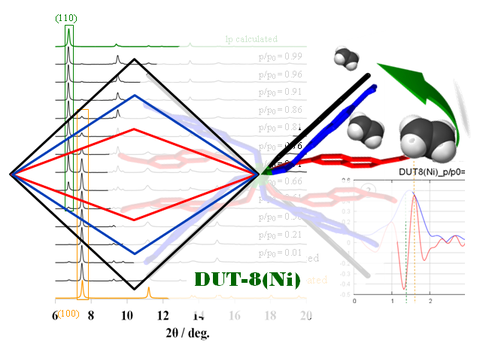Synthesis of switchable MOFs and in situ X-ray diffraction studies of gas and liquid phase induced reversible structural transformations
Duration: October 2016 - September 2019
In order to understand the role of metals and corresponding bonding situation (hinge energetics), the project will focus on the synthesis of pillared layer MOFs as model systems focusing on the di-nuclear paddle-wheel complexes (M2(O2C-R)4, M = Mn, Co, Ni, Cu, Zn) acting as nodes and 2,6-naphthalene dicarboxylate as linker (DUT-8). In this series, DUT-8(Ni) stands out in terms of volume change, while the other systems show a less pronounced gating effect. EPR spectroscopy will be used to analyze the effect of metal deficiencies in the open and closed phase. Mixed metal systems (M1M2(O2C-R)4; M1, M2 = Mn, Co, Ni, Cu, Zn etc.) will be synthesized to generate spectroscopically idealized model systems for studying in situ the switching phenomena using EPR spectroscopy. The model systems will be analyzed with respect to switching kinetics and in mixture adsorption systems to identify selective host-guest interactions during mixture gas adsorption in situ. The selectivity of host-switchability in contact with liquid guests using well defined model will be elucidated. DUT-8(Ni) will be used as a model system to study cooperative effects in the solid state transformation, i.e. particle size effects, and compositional variations. Thus, a key task will be to elaborate synthesis conditions for adjusting particle size distributions of DUT-8(Ni). Parallelized adsorption-diffraction and adsorption-EXAFS experimentation will be used to clearly identify the key factors inducing step-wise transitions between closed and open phases.

